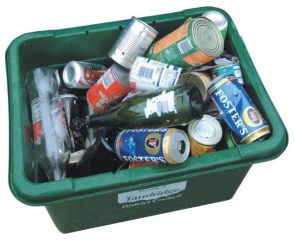The “Green New Deal” is a blanket term for an amorphous set of ideas about restructuring American society to address the coming climate crisis. If it does nothing else concrete, the Green New Deal has ignited long-overdue discussion about the destructive effects of climate change and practical solutions for mitigating the worst impacts.
In some ways, the climate crisis seems hopeless. What is required is massive, wholesale societal change, yet what has been most frequently proposed up to this point is tiny individual changes, such as eating less meat.
There is justified concern that larger changes to consumption, commodity pricing, and distribution models would be anathema to the citizenry, and thus unobtainable. But as I think about programs implemented in the past few decades, I think there is reason to be hopeful and optimistic about some of the changes required.

In the mid 1980s, California introduced a 5¢ fee on beverage containers, which could be recovered through recycling. Over time, an entire infrastructure sprung up around this market-based recycling approach. I fondly recall smashing soda cans in the garage as a kid, and then bringing a big bag of them to a recycling center near our supermarket in exchange for a voucher we could redeem for groceries. Recently this program has struggled as the result of a global shift in how recycling is processed, but even still 80% of beverage containers in California end up being recycled.
Starting in 2017, California banned single-use plastic shopping bags statewide. While there are a variety of exceptions, on the whole the entire state has shifted to reusable bags. This may feel like a large burden, but carrying reusable bags quickly becomes an ingrained behavior, and before long it feels completely normal:
For the most part, Californians took in stride the sudden absence of some 13 billion bags that in previous years were handed out at grocery checkout counters and by other retailers of all sorts. Maybe a few grumbled at first about the inconvenience. But most adjusted quickly, perhaps because they intuited that something was not right about all those plastic bags hanging from trees, caught up in storm drains, clumped by the sides of freeways and floating in the ocean.
Los Angeles Times
How do plastic bags and soda cans relate to the Green New Deal? Changes to our food distribution system will be critical to achieving the necessary carbon reduction targets. Taxes, caps, subsidies, or whatever other approach is chosen, at the end of the day, certain types of foods and transportation will become more expensive, and certain types of packaging will need to change.
Think about everything that comes from a grocery store, and just how much single-use packaging is involved. Every single-serving yogurt, granola bar, bag of chips, tub of hummus, frozen dinner, and clamshell case of strawberries is made up of single-use packaging that is devilishly difficult to recycle, if we even try.
On the other hand, glass, aluminum, cardboard? Pretty easy (assuming the packages are clean). The future I envision is more like Sprouts or Whole Foods than Ralphs and Safeway. More prepared foods made in-store, distributed in reusable plastic or aluminum trays that come with a redemption value attached. More large bins of bulk items — coffee, nuts, grains, snacks — that are distributed in reusable bags and tubs that we simple get used to bringing with us every time we shop.

A lot of the innovations in packaging in the last few decades have been around making products last longer in transport and on shelves. We have made the tradeoff of reducing food waste in exchange for distributing food in increasingly complex packaging that is impossible to recycle. This is an energy-intensive and petroleum-heavy endeavor, and I think the trend will need to shift the other way.
We will be faced with some level of reduced choice as the cost of carbon-heavy packaging and long-distance transportation rises, driving up the prices of foods that are distributed that way. Some of the biggest names in food production and distribution will not be able to adapt, and will go out of business. But we will shift towards more local production, more buying in bulk, and more local preparation.
It is not just transportation and packaging that needs a drastic change, it is also how we choose to subsidize food production. Right now we dramatically subsidize the cost of meat, dairy, snacks, and sugary beverages through our subsidies of sugarcane, soybeans, and corn. On the one hand this helps to prevent food shortages and ensures that high-caloric food is affordable. But more sustainable would be to shift in the opposite direction, towards foods that are inherently calorie-dense (and healthier) without many levels of processing and intermediate steps.

Will this raise the price of meat, cheese, and snacks? Sure it will. But if we can have a corresponding drop in the price of grains, fruits, and vegetables that are local and in season, consumption habits will adapt. Before long, our new food system will be the new normal.
The food system, including agriculture, packaging, and distribution is incredibly complex, and the shifts and changes will be far more consequential, difficult, and expensive than simply reducing plastic bag waste. But programs like the plastic bag ban, can recycling, and others like subsidies for solar panels and electric cars show that we do have the tools at the policy and economic level to address these problems in a systemic way. And they show that, done sensitively and carefully, such changes need not result in widespread suffering or anger.
I am not optimistic about our changes against the forces of nature and the impacts of over 100 year of industrialization, but I do believe there is a path forward. The fact that we have started talking about solutions — FINALLY! — gives me a little big of hope.
